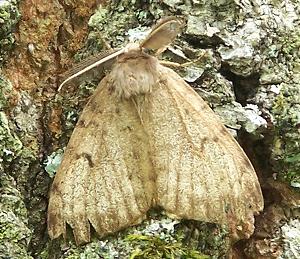Pike County Federation of Sportsmen's Clubs
Gypsy Moths
Normally we enjoy providing information about wildlife to new residents and visitors to Pike County. However, this is one animal we wish we did not have to: The Gypsy Moth.
The gypsy moth is the scourge of tree lovers. A voracious import that travels throughout the country leaving dead trees in its wake.
The gypsy moth, known to entomologists as Lymantria dispar, was introduced to America in the late 1860's. It was imported as part of an attempt to hybridize with silk moths to create a heartier moth with stronger silk. A few escaped and the troubles started.
Gypsy Moth Egg Mass (approx. 1 inch long)
Gypsy Moth eggs winter over on trees, rocks, houses, or wherever the female gypsy moth has laid them. They hatch in the spring and the caterpillars climb the nearest tree. Many of the caterpillars will be happy on the tree in which they have hatched. Others have a wanderlust. They climb out onto a tree branch, lower themselves on a long string of silk, then let the wind blow them to wherever they may land. As a result, areas may become heavily infested by caterpillars despite a lack of egg cases.
Mature Gypsy Moth Caterpillar (up to 2 inches long)
The caterpillars prefer hardwood trees. Oaks are a definite favorite. Apples and other fruit trees are also targets. But the caterpillars are not really fussy. They will eat almost any tree, including pines, when necessary. During heavy infestations, the caterpillars may totally defoliate acres and acres of land. Hikers walking through these areas hear the sound of rain as gypsy moth frass (excrement) falls from the trees and hits the ground.
Gypsy Moth frass ( droppings)
size increases as caterpillars grow - up to 1/4 inch diameter
Beginning mid-june, the caterpillars reach their full size and begin to pupate. They find a protected area, usually a niche in the tree's bark, but often under rocks, picnic tables, trailers, etc. They begin to spin strands of silk which melts into one another and forms a paper-like cocoon. In this cocoon the transformation begins.
Gypsy Moth Cocoons (approx. 1 inch long)
By August, the cocoons start to open. The males generally emerge first and the air is a flutter with light brown moths. Shortly thereafter, the females emerge. The females are flightless and climb the nearest tree, rock, or other tall object. There they await fertilization by the males and lay their eggs by the thousands. As the eggs are laid, the female encases them in a tough, fibrous case.

Male Gypsy Moth (approximately 1 inch long)
Female Gypsy Moth laying eggs (approximately 1 1/4 inch long)
The eggs winter over and the cycle begins anew.
Eventually predators, weather, and humans bring the gypsy moth populations under control. But they are never gone. Remnant populations remain and every year moths are seen fluttering around the forest.
Humans can kill gypsy moths in many ways. Property owners with few trees can scrape the egg masses into plastic bags to be disposed of in the trash. Caterpillars can also be hand picked and killed. On a large scale, aerial spraying is a must.
In the past, the government would spray the landscape with pesticides. This would not only kill gypsy moths, but also birds, small animals (particularly amphibians) and beneficial insects. Since spraying could not get every gypsy moth caterpillar, the infestations were often prolonged. Today, the government (and many property owners) spray Bacillus thuringiensis or Bt. Bt is a bacterium that is generally safe for all animals except caterpillars. (Note: there are other strains of Bt used to control other types of insects. If you purchase Bt, be sure you get the right type.) When Bt is ingested by the caterpillar, the results are usually fatal.
Today's spraying program is also different in that only areas of heavy gypsy moth populations are sprayed. The Bt spraying is designed to kill larger populations while leaving smaller populations alone. This is done to allow the gypsy moth's natural predators a chance to build up their numbers by feeding on the caterpillars. Eventually the predator populations increase to the point where spaying is no longer needed.
Predators of the gypsy moth include ichneumon flies, trichogramma wasps, and various predatory spiders, beetles, and ants. Chickadees, bluejays, and nuthatches consume their share as do deer mice, shrews, chipmunks, and squirrels. In rainy years, the caterpillars are susceptible to viruses and bacteria that kill them by the millions.